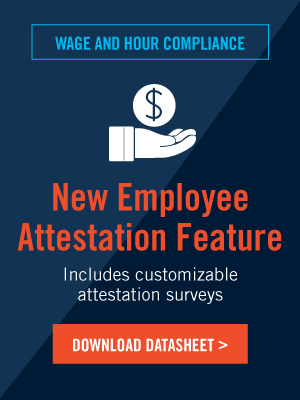Audit Timekeeping Systems to Avoid Wage & Hour Time Bombs

 HR and payroll professionals have embraced automated timekeeping systems saying goodbye to manually processing paper punch cards. These days electronic timekeeping is the norm, with the majority of employers using software programs to track employees’ hours and compute their pay. To take full advantage of the automated efficiencies, the rules of the time keeping software are configured based on policies and labor laws
HR and payroll professionals have embraced automated timekeeping systems saying goodbye to manually processing paper punch cards. These days electronic timekeeping is the norm, with the majority of employers using software programs to track employees’ hours and compute their pay. To take full advantage of the automated efficiencies, the rules of the time keeping software are configured based on policies and labor laws
To establish these rules and parameters, tough decisions are made to start but remember not to “set-it-and-forget-it”! Auditing these rules periodically, and especially when applicable laws change, is necessary to ensure wage and hour compliance.
Four areas employers can audit risk for wage-hour compliance.
Is Timecard Editing Possible?
Some software programs, including OnePoint Time and Attendance Module, allow supervisors to edit clock-in and clock-out times entered by an employee. While editing time records can be a useful and necessary tool, it is important to have an established internal processes and policy that align with the system's functionality. Moreover it is a good idea to restrict editing to a very select few individuals.
Obviously, the non-compliance risk here is that an untrained supervisors might not understand the wage and hour compliance implications of altering a timesheet. An approved supervisor should be aware of valid, compliant reasons to edit the time card in the first place. They should know not to have an incentive to cut payroll costs by shaving employees’ time, as this puts the company in great risk!
For added compliance scrutiny, OnePoint's time keeping system requires the editor to provide a comment for the reason for a timecard edit (i.e. employee forgot to punch back in after lunch). Additionally, OnePoint can capture an audit trail of who made the change, when and what was changed specifically for compliance audits.
Reconcile Functionality
Many time keeping software allows certain types of time entries to be flagged for additional scrutiny. For example, "reconciling" functionality can flag "early-in" punches or "late-out" punches.
Managers must be trained on how to properly utilize this functionality to ensure they do not have any incentive to to edit the entries thinking it will impose additional costs on the company which is against their incentive to meet budget. Reconcile flagging can also identify any overtime for review by a supervisor, giving the supervisor the option of approving or disapproving the entry. Unapproved overtime may subject the employee to discipline by an employer, the lack of approval does not make the hours non compensable under the wage-hour law.
Automatic meal period / break deductions
Timekeeping software can allow an employer to set up the system to automatically deduct meal or rest breaks from an employee's hours. Where the applicable wage-hour laws permit breaks to be unpaid, there is nothing unlawful about automatically deducting break time.
However, if the employee actually works through the break, overriding the deduction will require additional action by the employee and/or his or her supervisor. If the system defaults to deducting the break from the meal period, any omission or gap in the override system—whether the employee's failure to note the missed break, or the supervisor's failure to enter it into the system—favors the employee over the employer. The aggregate effect of the default break rule is equivalent to a form of wage-shaving.
To avoid this, the OnePoint system can set rules in which the employee can actually clock out for a paid break, but still get paid for it, thus avoiding this issue all together and furthermore going above and beyond regarding time keeping records for paid breaks. Additionally, the system can require employees to sign an attestation clause indicating that they have taken all their breaks and meal periods. Having the employee sign this statement can assist in a defense against meal period and break violations.
Automatic Rounding rules
Federal regulations authorizing rounding of employees’ work hours date back to 1961 and have not been amended since then. "At the time," the "rounding rule” represented a practical allowance from a pre digital era, where computing time sheets by hand by the minute, would have been extremely burdensome. No such efficiency-based justification exists for incorporating rounding into timekeeping software, which can both track and compute time at the millisecond level, automatically." Even facially neutral rounding rules "can act like casino odds when they interact with employer attendance policies—consistently favoring “the house”. The conservative approach would be to ensure all rounding rules result in being beneficial for the employee; not the employer.
The key to the success of Time and Attendance software acts as a partner to assist in compliance with rules, parameters, alerts, attestations and etc.; however, periodic auditing and updating is necessary in conjunction with training of time card reviewers and approvers is essential in remaining compliant. For more information about OnePoint workforce management solutions or to set up a customized demo for your company contact our team
Subscribe to updates
Get the latest posts delivered to your inbox.